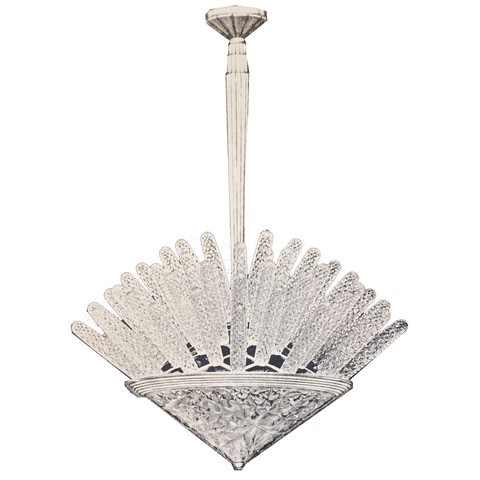Albert and Charles Simonet

The success of the Simonet company in the field of lighting was based on the partnership between Albert Simonet and the sculptor and glass artist Henri Dieupart. Albert and Charles Simonet both influenced the company’s management. Although Charles probably only appeared as a silent partner.
Albert Simonet’s first lamps were primarily made of bronze. Only in collaboration with Dieupart was bronze increasingly replaced by glass. From 1933 onwards, only excellently executed pressed glass dominated. Bronze appeared, if at all, only in the form of barely visible brackets. The company, launched by >Mobilier et Décoration< between 1924 and 1931 with many articles, successfully participated in almost all important exhibitions: 1924 in the Mars Pavilion and the Great Lighting Competition, 1925 at the International Exhibition, 1931 at the Exhibition of Contemporary Decorative Art, 1934 at the second Salon du Luminaire. As early as 1924, Albert and Charles Simonet received five of the ten main prizes offered in a competition organized by the Electricity Union, and it rained honorable mentions for the variety of his lighting designs, which suited apartments of all living standards.
The division of tasks between Simonet and Dieupart appears to have been clearly defined. Simonet was the theorist and designer. He evaluated all the new photometric results from the French laboratories for his designs. He based his lamps on “usage coefficients” that took into account the size, color, and desired brightness of the later rooms. These were determined mathematically, psychologically, and scientifically. This also reinforced his view that glass should be predominant in modern lighting. It placed Dieupart as a glass artist center stage.
Dieupart executed all of Simonet’s designs in cast glass. He achieved high-quality glass castings by pressing the glass into the mold with compressed air. He avoided using bright colors and mostly left the glass uncolored. Only occasionally, when the “usage coefficient” he had calculated required it, did he aim for a fine gray, violet, or iridescent sheen of color on the surface. His decorative motifs with mostly upward lines not only had a decorative purpose, but also served to make optimal use of light.
The production program ranged from large chandeliers, ceiling lights, and appliques. These were often put together to form illuminated friezes and cornices. It also included table lamps with bronze bases and transparent porcelain shades. These he created in collaboration with G.Henry. Albert and Charles Simonet initially focused on floral motifs such as morning glories, thistles, and ferns. However, over the course of the 1930s, geometric patterns dominated. The hymns of praise in the magazine Mobilier et Décoration seem justified. This is especially since almost all competitors except Lalique lacked the virtuosity and elegance presented here.
Source: Alastair Duncan, Lampen Lüster Leuchter, Jugendstil Art Déco, Prestel-Verlag, München 1979, p.184-185
Picture: Alastair Duncan, Lampen Lüster Leuchter, Jugendstil Art Déco, Prestel-Verlag, München 1979, picture 131

RSA Antiquitäten Wiesbaden is your antiques dealer in the Rhine-Main area. A large selection of original Art Deco, Biedermeier and Baroque furniture: high quality and exclusive. At RSA Antiquitäten Wiesbaden you can expect a large selection of expertly restored antiques. Exhibits from the Louis Seize, Biedermeier, and Art Deco periods are available.
The following artist glossary: Albert Cheuret

-
RSA Antiquitäten Wiesbaden
-
Taunusstraße 34
65183 Wiesbaden -
+49 611 5 29 05 70
-
+49 170 7 83 01 13
-
info@antiquitaeten-wiesbaden.de
-
Mondayclosed
-
Tuesday - Friday12 a.m. - 6 p.m.
-
Saturday10 a.m. - 4 p.m.